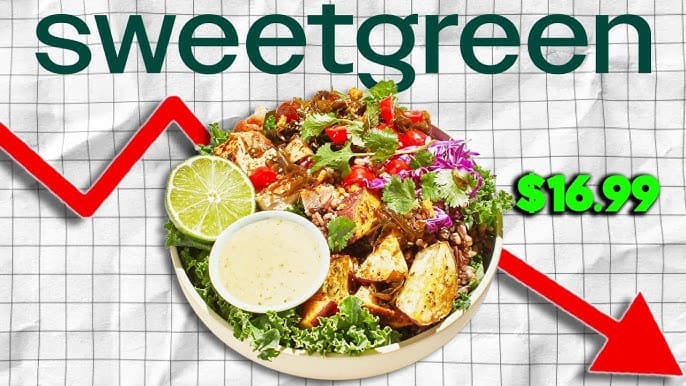
Unprofitable Sweetgreen cuts workers and fries
Sweetgreen’s Lunch Math No Longer Works The perennially unprofitable Sweetgreen cut 10% of open and existing roles within its support center teams recently, and will drop Ripple Fries from its menu, despite positive consumer feedback, CEO Jonathan Neman said on the chain’s Q2 earnings call.
Same-store sales fell 7.6%, and operating losses deepened to $26.4 million, a negative 14.2% margin. These are not growing-pain numbers. CFO Mitch Reback acknowledged that traffic and menu mix drove a nearly 10% decline, only slightly offset by price increases. Full-year guidance was cut to –4% to –6%, and the company laid off 10% of support-center staff.
Lunch-only is a business model, but also a limitation.
The company was built to dominate one day part: the weekday lunch rush. That made sense when urban professionals were commuting five days a week, looking for something healthier than fast food and more aspirational than a sandwich. Sweetgreen filled that lane perfectly, and built stores, labor models, and procurement around that 11:30 to 2:00 p.m. window.
But office work has changed. Hybrid schedules mean fewer downtown workers. Fewer workers mean fewer weekday visits. Sweetgreen doesn’t have meaningful business before 11:00 a.m. or after 3:00 p.m. It doesn’t sell breakfast. It doesn’t do late night. It doesn’t feed families at dinner. If the line isn’t moving during lunch, it’s not moving at all.
No Viable Breakfast or Dinner Strategy. Other brands aren’t stuck in that position. Chipotle can make up margin during dinner. Starbucks prints revenue during morning coffee and late-day beverage runs. Panera stretches into breakfast. McDonald’s lives across all day parts. But Sweetgreen is boxed into lunch. When weekday cadence weakens, revenue doesn’t shift—it disappears.
And with it goes their margin.
Sweetgreen’s food model isn’t built around shelf-stable inputs or frozen inventory. It’s fresh, raw, hyper-specific: roasted sweet potatoes, chopped kale, tamari sesame tofu, spicy cashew dressing. These ingredients are expensive to source, labor-intensive to prep, and sensitive to spoilage. A missed forecast doesn’t just mean food waste—it means higher variance in cost of goods sold and lower throughput on the line.
The problem isn’t just complexity—it’s operational fragility. The system has no margin for inefficiency. That became clear this quarter when the company made the decision to remove Ripple Fries, a popular new menu item that was hurting kitchen speed. As CEO Jonathan Neman put it, the fries “became a complexifier.” In stores where the fries were pulled, hold times dropped and customer satisfaction rose. That’s good execution triage—but also an admission that even one added station can break the system.
All of this would be manageable—if demand were still there.
It’s not. Sweetgreen’s same-store sales dropped 7.6% in Q2, and the company cut full-year guidance to –4% to –6%. CFO Mitch Reback acknowledged that traffic and shifting menu mix caused a 10% drop in performance, only partially offset by price increases. That means customers are visiting less often and buying different—possibly cheaper—items when they do.
Pricing is also hitting resistance. A Sweetgreen bowl can now push $15 to $18 depending on customizations and location. That felt acceptable in 2021, when the brand still had the sheen of post-pandemic optimism. But in 2025, with inflation fatigue and value menus returning across QSR, the consumer is rethinking whether a $15 salad is a weekly staple or an occasional splurge.
Sweetgreen’s leadership has acknowledged the challenge. To improve perceived value, they’re increasing protein portions by about 25% for chicken and tofu, and leaning back into seasonal menu innovation. But that creates a new bind: portion increases raise food cost, and menu churn adds new pressure on operations. It’s a game of margin whack-a-mole.
The financials reflect that squeeze.
Sweetgreen reported a $26.4 million operating loss in Q2—a margin of –14.2%, down from –8.8% last year. To stem the bleed, the company cut 10% of its support-center roles, pointing to a shift toward cost discipline. But that may not be enough to restore confidence.
The stock market is voting accordingly.
Sweetgreen’s shares are down meaningfully since their IPO. After the Q2 earnings call, they dropped further on weaker guidance and signs of negative operating leverage. Wall Street no longer treats the company like a growth story. It’s now a turnaround story—a lunch-only, ingredient-heavy, premium-priced concept fighting to restore frequency and stabilize margins.
Consumer behavior has shifted. Value is back. Predictable cadence is not. The brands winning right now are the ones with simple menu builds, broad daypart relevance, and a visible path to sub-$10 meals. Sweetgreen has none of those advantages today.